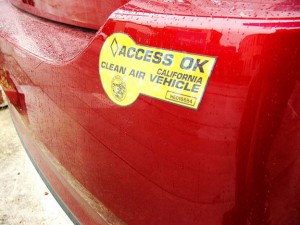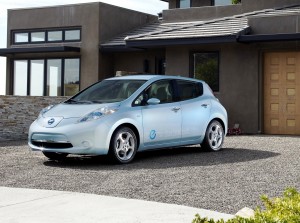
Prius, Insight and Civic Hybrid models with this sticker will no longer have access to California HOV lanes after December 31st.
For the past several years there’s been a booming gray market, in California, for the Toyota Prius. Not just any Prius, but specifically those which have an HOV access sticker pasted onto the bumper, a perk that can save a lucky, long-distance commuter an hour or more a day in travel time.
California regulators limited to 85,000 the number of High-Occupancy Vehicle stickers – which give access to the normally restricted car pool lanes. And only the three highest-mileage hybrids and electric vehicles, including the Prius, the Honda Insight and Honda Civic Hybrid qualified.
But as of December 31st, those three gas-electric models will have to fight it out for space on the I-405 and other crowded Golden State freeways along with Camry sedans, Ford Explorers and, gasp, gas-guzzling Chevy Silverado pickups.
While the Governator, California chief executive Arnold Schwarzenegger, has signed into law a 4-year extension of what had come to be known as the “Prius Perk,” the extension notably now excludes mere hybrids. The new focus is on pure battery power, something California regulators have been trying to promote since an ill-fated zero-emission law was briefly implemented back in the early 1990s.

Electric vehicles, like the new Nissan Leaf, will now be able to get the coveted HOV access stickers.
While the three hybrids will only be able to continue using the HOV lanes – with less than the minimum number of commuters in the vehicle – through December 31st, new stickers will be made available for those driving pure battery-electric vehicles, or BEVs, like the Tesla Roadster. The updated law will be particularly good news for Nissan, which launches its first BEV, the Leaf, late this year.
Vehicles running on natural gas, such as the Honda Civic GX, may also get HOV stickers, along with hydrogen cars like the Honda Clarity FCX Clarity and a fuel cell-powered version of the Chevrolet Equinox.
While AB 1500 notably omits the new generation of plug-in hybrids and extended-range electric vehicles about to reach market – such as the Toyota Prius plug-in and Chevy Volt extended-range electric vehicle, or E-REV – they could be added to the perk list under a separate California bill, SB 535, reports GreenCarReports.com.
The latest development will cut short the thriving trade in Prius, Insight and Civic Hybrids that boast the hard-to-get HOV stickers, the insurance claim processing firm Audatex reporting last year that an anointed vehicle could generate at least $1,200 more when sold. Some stickered models have reportedly been sold for an extra $5,000 on eBay. There’s also been a black market for counterfeit stickers, though the use of one, if a driver is caught, can be costly.
The cuts have generated a mixture of groans and cheers. Not surprisingly, those losing the perks are howling, though, “It can’t happen soon enough,” says Los Angeles commuter Charles Blake, one of many who complains that Prius drivers would often get in the left lanes and drive at or below the speed limit as they hyper-miled, oblivious of the long lines of traffic jamming up behind them.
Some early supporters, meanwhile, say the original Prius Park measure did its job, raising awareness of the hybrid technology to the point that special benefits are no longer necessary. Proponents are now turning their attention to the next generation of green technology, some of which could face a tougher sell, especially to those who commute long distances.
The Nissan Leaf, for example, has a rated range of 100 miles per charge, but the number can slip sharply when a motorist uses heat, air conditioning or lights. Plug-ins and E-REVs do have the advantage of having back-up gasoline motors that start up automatically when a vehicle’s battery runs down.

It was a good incentive. It helped to get the high mileage cars on the road and demonstrated that they worked. They are everywhere now and I hate to borrow a phrase from our dearly beloved ex-Prez, “Mission accomplished.” Just hope Santa Monica keeps its free parking for stickered Prius ordinance. I’ve saved at least $5.00.
Nice. Wonder where California is going to get the juice from? How many new electric power generating plants have been built or authorized in the state? Madness. They still can’t connect the dots in that greenist-pretending state of the Left Coast. I guess the CHiPs will have to start carrying a gallon of electricity for those stranded EVs.
It is gonna be ugly come January, when those 85,000 hybrids are forced over into the congestion in the already-clogged regular lanes. Why doesn’t the state extend a couple of years, until there are enough BEVs to replace the Hybrids?
while i can see it is no longer fair to new owners of hybrids, i do see a huge problem coming up.
now all the hybrids will congest the regular lanes making traffic even worse for commuters.
i think it is a good incentive to look at the electric cars, but what about those who have 40+ miles commute each way and no charge available at their place of work.
perhaps the initiative is just a few years to soon…
Hi, Per,
There are many who argue the push for electric vehicles is a bit premature. As for the small percentage of those with truly long commutes who might consider a Prius plug-in, with only 17-mile battery range, or a 40-mile Chevy Volt, they will either have to settle for driving part of the way on gasoline or looking for an alternative. Government data suggest barely 1 in 3 American motorists drive over 40 miles to work and back each day, however. For them, if they truly want to operate solely on electric propulsion there’s the Nissan Leaf, with 100 mile range, which launches late 2010. Other battery-electric models with similar range, like the Ford Focus Electric, will follow.
Paul A. Eisenstein
Publisher, TheDetroitBureau.com